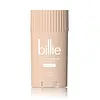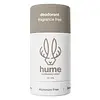What's inside
What's inside
 Key Ingredients
Key Ingredients

 Benefits
Benefits

 Concerns
Concerns

 Ingredients Side-by-side
Ingredients Side-by-side

Propanediol
SolventWater
Skin ConditioningTapioca Starch
Sodium Stearate
CleansingDimethyl Lauramide/Myristamide
EmulsifyingDiatomaceous Earth
AbrasiveGlycerin
HumectantParfum
MaskingSilica
AbrasiveGlyceryl Caprylate
EmollientSaccharomyces Ferment Filtrate
HumectantLactobacillus/Papaya Fruit Ferment Extract
AbrasiveAllantoin
Skin ConditioningEthylhexylglycerin
Skin ConditioningAvena Sativa Kernel Flour
AbrasiveCarica Papaya Seed Oil
HumectantAnanas Sativus Fruit Extract
Skin ConditioningBisabolol
MaskingAloe Barbadensis Leaf Juice
Skin ConditioningBenzyl Alcohol
PerfumingCoumarin
PerfumingHydroxycitronellal
PerfumingLactobacillus Ferment
Skin ConditioningFarnesol
PerfumingBenzyl Salicylate
PerfumingBenzyl Benzoate
AntimicrobialLimonene
PerfumingGlyceryl Undecylenate
EmollientMaltodextrin
AbsorbentPropanediol, Water, Tapioca Starch, Sodium Stearate, Dimethyl Lauramide/Myristamide, Diatomaceous Earth, Glycerin, Parfum, Silica, Glyceryl Caprylate, Saccharomyces Ferment Filtrate, Lactobacillus/Papaya Fruit Ferment Extract, Allantoin, Ethylhexylglycerin, Avena Sativa Kernel Flour, Carica Papaya Seed Oil, Ananas Sativus Fruit Extract, Bisabolol, Aloe Barbadensis Leaf Juice, Benzyl Alcohol, Coumarin, Hydroxycitronellal, Lactobacillus Ferment, Farnesol, Benzyl Salicylate, Benzyl Benzoate, Limonene, Glyceryl Undecylenate, Maltodextrin
Propylene Glycol
HumectantWater
Skin ConditioningSodium Stearate
CleansingPropanediol
SolventDiatomaceous Earth
AbrasiveSilica
AbrasiveSaccharomyces Ferment Filtrate
HumectantAloe Barbadensis Leaf Juice
Skin ConditioningOpuntia Ficus-Indica Seed Oil
EmollientLactobacillus Ferment
Skin ConditioningCocos Nucifera Fruit Extract
EmollientCereus Grandiflorus Flower Extract
Skin ConditioningKaolin
AbrasiveTapioca Starch
Glycerin
HumectantSorbitan Stearate
EmulsifyingStearyl Alcohol
EmollientEthylhexylglycerin
Skin ConditioningCaprylyl/Capryl Glucoside
CleansingPolyglyceryl-10 Caprylate
EmulsifyingPolyglyceryl-5 Oleate
EmulsifyingGlyceryl Caprylate
EmollientSodium Cocoyl Glutamate
CleansingCitric Acid
BufferingPropylene Glycol, Water, Sodium Stearate, Propanediol, Diatomaceous Earth, Silica, Saccharomyces Ferment Filtrate, Aloe Barbadensis Leaf Juice, Opuntia Ficus-Indica Seed Oil, Lactobacillus Ferment, Cocos Nucifera Fruit Extract, Cereus Grandiflorus Flower Extract, Kaolin, Tapioca Starch, Glycerin, Sorbitan Stearate, Stearyl Alcohol, Ethylhexylglycerin, Caprylyl/Capryl Glucoside, Polyglyceryl-10 Caprylate, Polyglyceryl-5 Oleate, Glyceryl Caprylate, Sodium Cocoyl Glutamate, Citric Acid
Ingredients Explained
These ingredients are found in both products.
Ingredients higher up in an ingredient list are typically present in a larger amount.
Aloe Barbadensis Leaf Juice comes from leaves of the aloe plant. Aloe Barbadensis Leaf Juice is best known for helping to soothe sunburns. It is also anti-inflammatory, moisturizing, antiseptic, and can help heal wounds.
Aloe is packed with good stuff including Vitamins A, C, and E. These vitamins are antioxidants, which help fight free-radicals and the damage they may cause. Free-radicals are molecules that may damage your skin cells, such as pollution.
Aloe Barbadensis Leaf Juice also contains sugars. These sugars come in the form of monosaccharides and polysaccharides, folic acid, and choline. These sugars are able to help bind moisture to skin.
It also contains minerals such as calcium, 12 anthraquinones, fatty acids, amino acids, and Vitamin B12.
Learn more about Aloe Barbadensis Leaf JuiceDiatomaceous Earth is an exfoliant.
Ethylhexylglycerin (we can't pronounce this either) is commonly used as a preservative and skin softener. It is derived from glyceryl.
You might see Ethylhexylglycerin often paired with other preservatives such as phenoxyethanol. Ethylhexylglycerin has been found to increase the effectiveness of these other preservatives.
Glycerin is already naturally found in your skin. It helps moisturize and protect your skin.
A study from 2016 found glycerin to be more effective as a humectant than AHAs and hyaluronic acid.
As a humectant, it helps the skin stay hydrated by pulling moisture to your skin. The low molecular weight of glycerin allows it to pull moisture into the deeper layers of your skin.
Hydrated skin improves your skin barrier; Your skin barrier helps protect against irritants and bacteria.
Glycerin has also been found to have antimicrobial and antiviral properties. Due to these properties, glycerin is often used in wound and burn treatments.
In cosmetics, glycerin is usually derived from plants such as soybean or palm. However, it can also be sourced from animals, such as tallow or animal fat.
This ingredient is organic, colorless, odorless, and non-toxic.
Glycerin is the name for this ingredient in American English. British English uses Glycerol/Glycerine.
Learn more about GlycerinGlyceryl Caprylate comes from glycerin and caprylic acid, a fatty acid from coconut. It has emollient and emulsifier properties.
As an emollient, it helps hydrate your skin. Emollients work by creating a barrier on your skin to trap moisture in, helping to keep your skin soft and smooth.
On the other hand, emulsifiers prevent ingredients (such as oil and water) from separating.
Learn more about Glyceryl CaprylateLactobacillus Ferment is created by fermenting the Lactobacillus bacteria. It helps keep our skin's natural barrier and microbiome healthy.
Studies show lactobacillus ferment to be effective at repairing the skin barrier. Having a healthy skin barrier helps keep your skin healthy and hydrated. It also protects against bad bacteria.
As a probiotic/prebiotic/postbiotic, Lactobacillus ferment can help regular our natural biome. In fact, one study found a lack of diversity in our natural skin biome can trigger acne.
Learn more about Lactobacillus FermentPropanediol is an all-star ingredient. It softens, hydrates, and smooths the skin.
It’s often used to:
Propanediol is not likely to cause sensitivity and considered safe to use. It is derived from corn or petroleum with a clear color and no scent.
Learn more about PropanediolSaccharomyces Ferment Filtrate is created from fermenting Saccharomyces, a yeast also known as baker's yeast or brewer's yeast.
As a humectant, Saccharomyces Ferment Filtrate helps draw moisture from the air to your skin to keep your skin hydrated. The humectant properties comes from its beta-glucan content.
Silica, also known as silicon dioxide, is a naturally occurring mineral. It is used as a fine, spherical, and porous powder in cosmetics.
Though it has exfoliant properties, the function of silica varies depending on the product.
The unique structure of silica enhances the spreadability and adds smoothness, making it a great texture enhancer.
It is also used as an active carrier, emulsifier, and mattifier due to its ability to absorb excess oil.
In some products, tiny microneedles called spicules are made from silica or hydrolyzed sponge. When you rub them in, they lightly polish away dead skin layers and enhance the penetration of active ingredients.
Learn more about SilicaSodium stearate is the sodium salt of stearic acid.
The structure of sodium stearate makes it both a cleanser and emulsifier. As a cleanser, it helps dissolve dirt, oil, and other pollutants. As an emulsifier, it helps prevent ingredients from separating. This adds stability to the formula.
Tapioca starch is a thickening agent and is made from the cassava root, also known as yucca.
According to a manufacturer, it is an excellent talc replacement.
It is gluten-free.
Learn more about Tapioca StarchWater. It's the most common cosmetic ingredient of all. You'll usually see it at the top of ingredient lists, meaning that it makes up the largest part of the product.
So why is it so popular? Water most often acts as a solvent - this means that it helps dissolve other ingredients into the formulation.
You'll also recognize water as that liquid we all need to stay alive. If you see this, drink a glass of water. Stay hydrated!
Learn more about Water